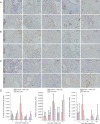Beta-nerve growth factor promotes neurogenesis and angiogenesis during the repair of bone defects
- PMID: 26330843
- PMCID: PMC4541251
- DOI: 10.4103/1673-5374.160114
Beta-nerve growth factor promotes neurogenesis and angiogenesis during the repair of bone defects
Abstract
We previously showed that the repair of bone defects is regulated by neural and vascular signals. In the present study, we examined the effect of topically applied β-nerve growth factor (β-NGF) on neurogenesis and angiogenesis in critical-sized bone defects filled with collagen bone substitute. We created two symmetrical defects, 2.5 mm in diameter, on either side of the parietal bone of the skull, and filled them with bone substitute. Subcutaneously implanted osmotic pumps were used to infuse 10 μg β-NGF in PBS (β-NGF + PBS) into the right-hand side defect, and PBS into the left (control) defect, over the 7 days following surgery. Immunohistochemical staining and hematoxylin-eosin staining were carried out at 3, 7, 14, 21 and 28 days postoperatively. On day 7, expression of β III-tubulin was lower on the β-NGF + PBS side than on the control side, and that of neurofilament 160 was greater. On day 14, β III-tubulin and protein gene product 9.5 were greater on the β-NGF + PBS side than on the control side. Vascular endothelial growth factor expression was greater on the experimental side than the control side at 7 days, and vascular endothelial growth factor receptor 2 expression was elevated on days 14 and 21, but lower than control levels on day 28. However, no difference in the number of blood vessels was observed between sides. Our results indicate that topical application of β-NGF promoted neurogenesis, and may modulate angiogenesis by promoting nerve regeneration in collagen bone substitute-filled defects.
Keywords: angiogenesis; collagen; nerve regeneration; neural regeneration; protein gene product 9.5; vascular endothelial growth factor; β III-tubulin; β-nerve growth factor.
Conflict of interest statement
Figures





Similar articles
-
A pilot study evaluating the effect of recombinant human bone morphogenetic protein-2 and recombinant human beta-nerve growth factor on the healing of Class III furcation defects in dogs.J Periodontol. 2010 Sep;81(9):1289-98. doi: 10.1902/jop.2010.090655. J Periodontol. 2010. PMID: 20397902
-
Facilitate Angiogenesis and Neurogenesis by Growth Factors Integrated Decellularized Matrix Hydrogel.Tissue Eng Part A. 2021 Jun;27(11-12):771-787. doi: 10.1089/ten.TEA.2020.0227. Epub 2020 Nov 20. Tissue Eng Part A. 2021. PMID: 33107410
-
Simultaneous inferior alveolar nerve regeneration and osseointegration with a nerve growth factor-supplying implant: a preliminary study.J Oral Maxillofac Surg. 2015 Mar;73(3):410-23. doi: 10.1016/j.joms.2014.07.009. Epub 2014 Jul 18. J Oral Maxillofac Surg. 2015. PMID: 25266595
-
Nerve growth factor promotes reparative angiogenesis and inhibits endothelial apoptosis in cutaneous wounds of Type 1 diabetic mice.Diabetologia. 2004 Jun;47(6):1047-54. doi: 10.1007/s00125-004-1414-7. Epub 2004 May 26. Diabetologia. 2004. PMID: 15164170
-
Cross talk between the cardiovascular and nervous systems: neurotrophic effects of vascular endothelial growth factor (VEGF) and angiogenic effects of nerve growth factor (NGF)-implications in drug development.Curr Pharm Des. 2006;12(21):2609-22. doi: 10.2174/138161206777698738. Curr Pharm Des. 2006. PMID: 16842161 Review.
Cited by
-
Effects of Early Life Stress on Bone Homeostasis in Mice and Humans.Int J Mol Sci. 2020 Sep 10;21(18):6634. doi: 10.3390/ijms21186634. Int J Mol Sci. 2020. PMID: 32927845 Free PMC article.
-
Function of peripheral nerves in the development and healing of tendon and bone.Semin Cell Dev Biol. 2022 Mar;123:48-56. doi: 10.1016/j.semcdb.2021.05.001. Epub 2021 May 13. Semin Cell Dev Biol. 2022. PMID: 33994302 Free PMC article. Review.
-
The evolution of nerve growth factor inhibition in clinical medicine.Nat Rev Rheumatol. 2021 Jan;17(1):34-46. doi: 10.1038/s41584-020-00528-4. Epub 2020 Nov 20. Nat Rev Rheumatol. 2021. PMID: 33219344 Review.
-
A Pharmacological Rationale to Reduce the Incidence of Opioid Induced Tolerance and Hyperalgesia: A Review.Pain Ther. 2018 Jun;7(1):59-75. doi: 10.1007/s40122-018-0094-9. Epub 2018 Mar 28. Pain Ther. 2018. PMID: 29594972 Free PMC article. Review.
-
Tissue Engineered Neurovascularization Strategies for Craniofacial Tissue Regeneration.ACS Appl Bio Mater. 2022 Jan 17;5(1):20-39. doi: 10.1021/acsabm.1c00979. Epub 2021 Nov 29. ACS Appl Bio Mater. 2022. PMID: 35014834 Free PMC article. Review.
References
-
- Asanome A, Kawabe JI, Matsuki M, Kabara M, Hira Y, Bochimoto H, Yamauchi A, Aonuma T, Takehara N, Watanabe T, Hasebe N. Nerve growth factor stimulates regeneration of perivascular nerve, and induces the maturation of microvessels around the injured artery. Biochem Biophys Res Commun. 2014;443:150–155. - PubMed
-
- Brentegani LG, Bombonato KF, Carvalho TL. Histological evaluation of the biocompatibility of a glass-ionomer cement in rat alveolus. Biomaterials. 1997;18:137–140. - PubMed
-
- Chen WH, Zhuo LL, Mao CQ, Wang J, Lu M, Wang CY. Establishment of a model for β-NGF administration in rat skull bone defect. Fujian Yike Daxue Xuebao. 2014;48:303–307.
-
- Emanueli C, Salis MB, Pinna A, Graiani G, Manni L, Madeddu P. Nerve growth factor promotes angiogenesis and arteriogenesis in ischemic hindlimbs. Circulation. 2002;106:2257–2262. - PubMed
LinkOut - more resources
Full Text Sources
Other Literature Sources
